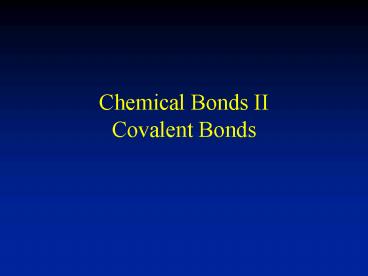Chemical Bonds II Covalent Bonds - PowerPoint PPT Presentation
1 / 28
Title:
Chemical Bonds II Covalent Bonds
Description:
Covalent bonding- valence e are shared between atoms ... 1. Add the number of valence electrons from ... Mono-di-tri-tetra-penta-hexa. 6. Sample Test Questions ... – PowerPoint PPT presentation
Number of Views:205
Avg rating:3.0/5.0
Title: Chemical Bonds II Covalent Bonds
1
Chemical Bonds IICovalent Bonds
2
Covalent Bonds Sharing e
1
- Covalent bonding- valence e are shared between
atoms - Number of unpaired valence e is perfect
indicator of how many bonds an atom needs to form
to become stable
3
Covalent Bond Formation
2
4
Electron Dot Structures
3
- 1. Add the number of valence electrons from each
atom in the formula. - 2. Join atoms with covalent bonds.
- 3. For each bond, subtract 2 from the total
electrons to account for. Use the leftover
electrons to give each atom 8 electrons (except
H). - 4. Repeat as necessary.
5
Some of the Ways Molecules Trick Us
4
- Multiple Covalent Bonds- double and triple bonds
can form between two atoms - CO2 N2
6
Some of the Ways Molecules Trick Us
4
- Coordinate Covalent Bond- one atom contributes
both electrons to a bond
7
Some of the Ways Molecules Trick Us
4
- Exceptions- Be, B, P, S, N
- BeH2 BCl3 PCl5 SF6 NO
8
Naming Covalent Compounds
5
- Name of first element root of second
element suffix -ide - must use prefixes to denote how many of each
- Mono-di-tri-tetra-penta-hexa
9
Sample Test Questions
6
- Classify the following compound as ionic or
covalent SO2 - What is the name of N2O4?
- What is the formula of dihydrogen monoxide?
- Draw the Lewis dot structure of SiCl4. Include
all lone pairs in the diagram. - Draw the Lewis dot structure of silicon dioxide.
Include all lone pairs in the diagram. - Draw the Lewis dot structure of PBr5. Include all
lone pairs in the diagram. This compound
violates the octet rule.
10
Shapes of Molecules
7
- VSEPR theory is used to predict the shape (and
therefore reactivity) of a molecule. - VSEPR- Valence-Shell Electron-Pair Repulsion
11
1. Electron pairs in four locations.
8
- 109o separation of electrons
- Shape Example molecule
- Linear HCl
- Bent H2O
- Pyramidal NH3
- Tetrahedral CH4
12
2. Electron pairs in three locations.
9
- 120o separation of electrons
- Shape Example molecule
- Triangular BCl3
13
3. Electron pairs in two locations.
10
- 180o separation of electrons
- Shape Example molecule
- Only linear CO2
14
4. Electron pairs in one location.
11
- no separation of electrons
- Shape Example molecule
- Linear only example is H2
15
Sample Test Question
12
- What is the shape of the following molecule, for
which the correct Lewis dot structure is given?
O Se - O
16
Sample Test Question
13
- Draw the Lewis dot structure for a molecule of
SCl2.
17
Sample Test Question
14
- What is the molecular shape of phosphorous
trifluoride?
18
Polar Bonds
15
- When two atoms of different electronegativity
bond, a dipole (dipole moment) is the result. - dipole moment- a molecule has separated centers
of partial positive (?) and partial negative
(??) charge.
19
Sample Test Question
16
- Using chart 1, determine the type of bond
involved between the following pairs of elements. - C-H ______
- C-Cl ______
- N-H ______
- Ca-Cl ______
20
Determining if a Bond is Polar
17
- Determine the difference in electronegativity of
the two atoms involved (given in chart form). - C-H ______
- C-Cl ______
- N-H ______
- Ca-Cl ______
21
Determining if a Bond is Polar
18
- 1. Determine the difference in electronegativity
of the two atoms involved (given in chart form). - 2. Difference in electronegativity determines
the type of bond
22
19
Examples CsF NaCl HCl CH4 H2
23
Determining if a Bond is Polar
20
- 1. Determine the difference in electronegativity
of the two atoms involved (given in chart form). - 2. Difference Type of bond
- lt 0.5 Nonpolar Covalent
- 0.5-2.0 Polar Covalent
- gt 2.0 Ionic
24
Generalizations
21
- 1. Bonds involving the same element cannot be
polar. - 2. The further away elements are on the periodic
table, the more likely they are to be ionic.
25
Polar and Nonpolar Molecules
22
- Molecules with polar bonds can be nonpolar if the
dipole moments counter-balance each other.
26
Sample Test Question
23
- Classify the following molecules as polar or
nonpolar. - OFH ______
- CH2Cl2 ______
- CF4 ______
- CH4 ______
27
Properties of Covalent and Ionic Compounds
24
- Ionic Covalent
- metal-nonmetal nonmetal-nonmetal
- solid solid, liquid or gas
- hard and brittle (salt) brittle and weak
(sugar) or soft and waxy (butter) - high mp and bp low mp and bp
- soluble in water solubility varies widely
- nonconductor if solid insulators or conductor
if liquid
28
What Do Compounds Really Look Like?
25































